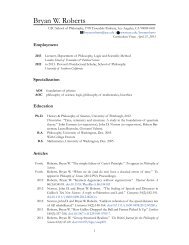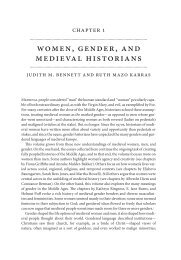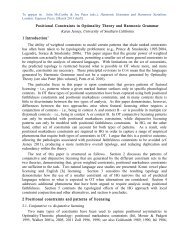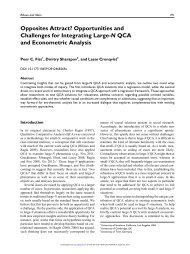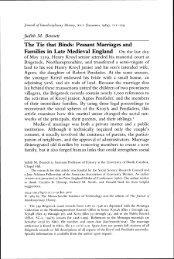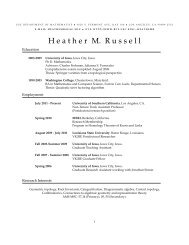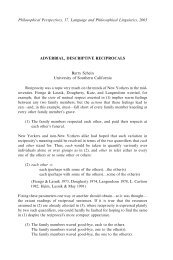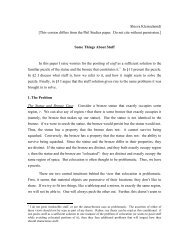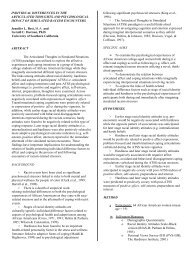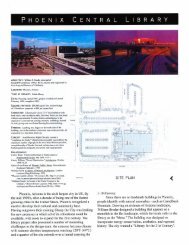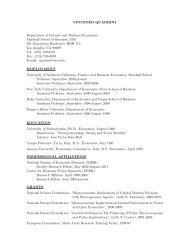The Racial Resegregation of Los Angeles County, 1940-2000
The Racial Resegregation of Los Angeles County, 1940-2000
The Racial Resegregation of Los Angeles County, 1940-2000
Create successful ePaper yourself
Turn your PDF publications into a flip-book with our unique Google optimized e-Paper software.
great variety <strong>of</strong> race-ethnic identities, from Vietnamese to Chinese, Korean, and<br />
Japanese. We cannot deal with the rationality <strong>of</strong> this system here, but again we are<br />
following convention by treating Asians as a single category. We include as well Pacific<br />
Islanders and Native Hawaiians in this category. Native Americans and all those<br />
classified as “other race,” all totaling less than 1% <strong>of</strong> the <strong>Los</strong> <strong>Angeles</strong> <strong>County</strong> population,<br />
have also been added to the Asian category, for reasons <strong>of</strong> compatibility with the <strong>1940</strong>-<br />
1990 data series.<br />
Thus, for reasons <strong>of</strong> simplicity and common sense, “Whites” (in reality Euro-Americans)<br />
are called “Whites,” Non-Hispanic African Americans are called “Blacks”; “Hispanics”<br />
and “Latinos” are used interchangeably and Asians and Pacific Islanders are called<br />
“Asians.”<br />
2.3 Explanation <strong>of</strong> the Segregation Indices<br />
For a complete discussion <strong>of</strong> the three main indices <strong>of</strong> segregation used in this study, see<br />
Lieberson (1981), Massey and Denton (1988), White (1983), and White (1986). <strong>The</strong><br />
following is only a brief overview.<br />
2.31 <strong>The</strong> Diversity Index<br />
<strong>The</strong> Diversity Index ranges from 0 to about 1.4, and increases as the four racial groups<br />
become more balanced within tracts, regardless <strong>of</strong> their proportion in the <strong>County</strong> as a<br />
whole. <strong>The</strong> table below shows the Diversity Index and percentage racial populations for<br />
five tracts in the year <strong>2000</strong>: the least diverse, the 25 th percentile, the median, the 75th<br />
percentile, and the most diverse. Note that the actual population proportions for the<br />
county as a whole in <strong>2000</strong> were 32% White; 9.7% Black, 44.6% Hispanic, and 13.7%<br />
Asian.<br />
Tract Diversity<br />
Index<br />
White Black Hispanic Asian Percentile<br />
6<strong>2000</strong>3 0.00 100% 0% 0% 0% Lowest<br />
541400 0.66 1% 26% 73% 1% 25 th<br />
297000 0.87 69% 3% 21% 7% Median<br />
311800 1.06 36% 3% 50% 10% 75 th<br />
572201 1.37 24% 19% 25% 32% Highest<br />
2.32 <strong>The</strong> Index <strong>of</strong> Dissimilarity<br />
<strong>The</strong> Index <strong>of</strong> Dissimilarity, or “ID,”is the most commonly used measure <strong>of</strong> “segregation” in<br />
American social science since the 1950s. Based always on a comparison <strong>of</strong> two groups (eg,<br />
White vs. Nonwhites, Blacks vs. Nonblacks), this measure is very easy to interpret. <strong>The</strong> Index <strong>of</strong><br />
Dissimilarity ranges from 0 to 1 (or 0% to 100%), and tells us the percentage <strong>of</strong> a given<br />
population that would have to change its residential location in order to even-out the distribution<br />
<strong>of</strong> that groups across the metropolitan space. If Blacks were evenly settled across the entire<br />
Race Contours <strong>2000</strong> –<strong>Resegregation</strong> <strong>of</strong> <strong>Los</strong> <strong>Angeles</strong> <strong>County</strong>, <strong>1940</strong>-<strong>2000</strong> 5



